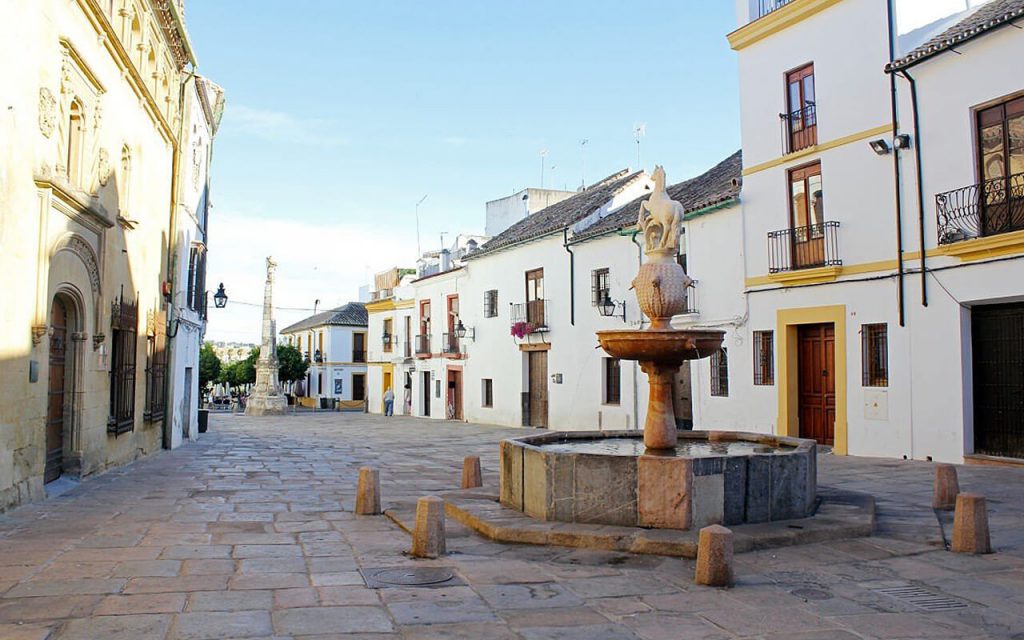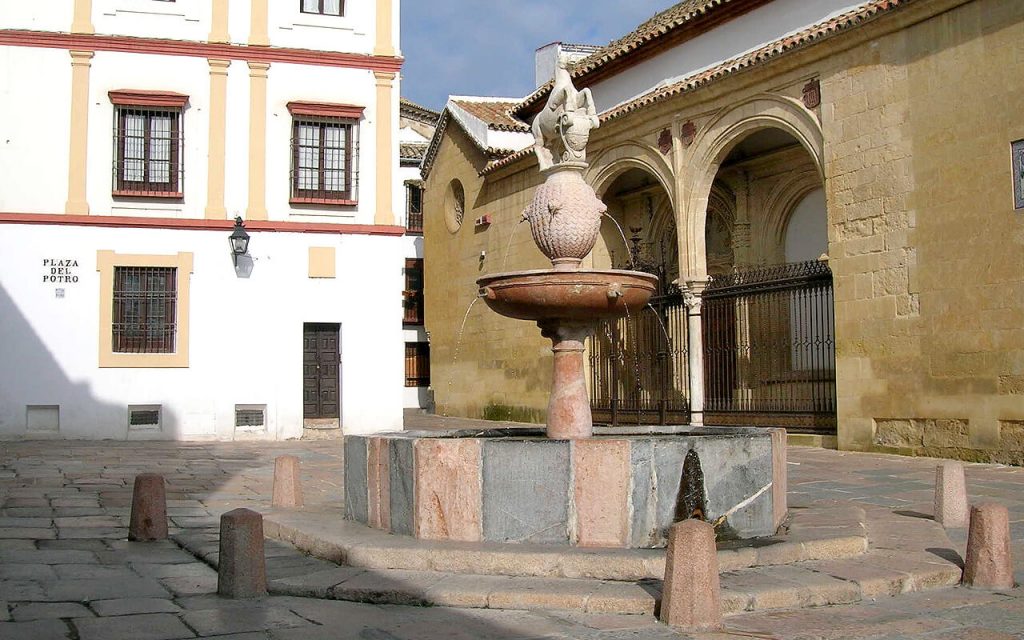Índice Contenido
The Plaza del Potro in Córdoba is located in the San Francisco-Ribera neighborhood and represents a symbol of the city’s history. The name is thought to be primarily due to the fountain located in the center of the square, which features a horse figure with the coat of arms of Córdoba. Other theories refer to the Posada del Potro, which was located in the square and could have given rise to its name. Finally, it is known that during the Middle Ages, a livestock fair was held in the vicinity, so the square was a place dedicated to the sale of horses and most likely originated this peculiar denomination.
In addition to the fountain, the Plaza del Potro contains several key tourist and cultural sites, starting with the Julio Romero de Torres Museum, which shares the building with the Museum of Fine Arts of Córdoba, the Posada del Potro which also houses the Peña Flamenca, and finally, one of the Triunfos de San Rafael that can be found throughout Córdoba.
Where is Plaza del Potro?
The Plaza del Potro in Córdoba is a rectangular square that borders Calle Lucano and Calle Enrique Romero de Torres to the south, and Romero Barros and San Francisco Streets to the north. It is located very close to the river Guadalquivir waterfront. The San Francisco-Ribera neighborhood, where it is located, is adjacent to emblematic places in Córdoba such as the Plaza de la Corredera and the Church of San Pedro.
How to get to Plaza del Potro
The Plaza del Potro in Córdoba is located in the historic center of the city, making it very easy to reach on foot from any of its monuments. However, there are nearby bus and taxi stops that will undoubtedly be useful.
How to get to Plaza del Potro in Córdoba from the Mosque
How to get to Plaza del Potro in Córdoba from Plaza de las Tendillas
How to get to Plaza del Potro in Córdoba from Hotel Córdoba Center
How to get to Plaza del Potro in Córdoba from Hotel Eurostars Palace
How to get to Plaza del Potro in Córdoba from the AVE RENFE Station

History of Plaza del Potro
The Plaza del Potro has its origins in the Middle Ages. Initially, it was completely square and was enclosed and surrounded by buildings. In the 15th century, the Hospital de la Caridad was founded, and the size of the square was further reduced.
Later, in 1577, while García Suárez de Carvajal was the Corregidor (governor) of the city, the famous fountain that adorns the square was installed. In 1847, it was decided to move the fountain from one end to the other of the square and add the figure of the foal.
In 1870, the City Council was able to expropriate the Posada de la Madera, a building located in the southern part of the square, and demolish it to create the open square as we know it today. This way, the Plaza del Potro became fully accessible from the waterfront.
At the southern end of the Plaza del Potro, there is a Triunfo de San Rafael (Triumph of San Rafael). Originally, it was installed in the Plaza del Ángel, and in 1924 it was decided to move it to the Plaza del Potro.
As a curiosity, there is a replica of the horse sculpture from the fountain in the Plaza de Belén in Jerez. This was a gift from the city of Córdoba as part of their twinning in 1964.
In addition, the Plaza del Potro is mentioned in Miguel de Cervantes’ work Don Quijote de la Mancha on several occasions, most likely due to the time the writer spent in the city of Córdoba during his childhood, specifically in a house in the vicinity of the square.
Fountain of Plaza del Potro
The Fountain of Plaza del Potro is a Renaissance monument located in the popular Plaza del Potro in Córdoba. It was installed in 1577 and consists of an octagonal basin and a circular bowl, in which a statue of a foal and the city’s coat of arms stand out. It is composed of eight water jets, four in the upper part and four in the lower structure of the fountain.
It is a drinking water fountain, allowing water to be poured from the top of the fountain into any container, using any of the jets.

Legend of Plaza del Potro
The legend of Plaza del Potro tells the story of a captain of King Pedro I from the 14th century, nicknamed “El Cruel” (The Cruel). This soldier stayed overnight at the inn in the square and became enamored with a young woman who attended to him. The innkeeper accommodated the captain in one of his best rooms. However, the young woman warned the soldier about the innkeeper’s malicious intentions and advised him not to spend the night there.
Taking the warning into account, the captain waited until late at night and discovered the innkeeper entering the room through a trapdoor, intending to kill him and rob him. Luckily, the captain managed to escape and went to Seville, where the King had his court. There, he told the monarch the story of the innkeeper, after which the King decided to go to Córdoba to confront him and seek justice. In the famous inn, they discovered piles of corpses, all belonging to the unfortunate individuals whom the innkeeper had murdered and robbed. The enraged King ordered the innkeeper to be dismembered in the square, tying his limbs to several horses. Additionally, the King agreed to the marriage between the beautiful young woman and the captain, and bestowed upon them the riches found in the inn.
Frequently Asked Questions about Plaza del Potro
- What is the relationship between Plaza del Potro and Miguel de Cervantes?
Miguel de Cervantes spent part of his childhood living in the vicinity of Plaza del Potro in Córdoba, which is why he decided to include it in his work Don Quijote de la Mancha, making reference to it on several occasions.
- When was Plaza del Potro built?
The Plaza del Potro has its origins in the Middle Ages, although its current structure dates back more recently to 1870, when the building that closed its access to the waterfront was demolished.
- What is there to see in Plaza del Potro?
Plaza del Potro is a place where several monuments are concentrated, starting with the Fountain of Potro and the Posada del Potro, which is also the headquarters of the Peña Flamenca. In addition, you can also visit the Julio Romero de Torres Museum, the Museum of Fine Arts, and one of the Triunfos de San Rafael.
- Where is Plaza del Potro located?
The Plaza del Potro is located in the San Francisco-Ribera neighborhood, bordered by Lucano Street to the south and San Francisco Street to the north. It has access from the waterfront through Enrique Romero de Torres Street.

